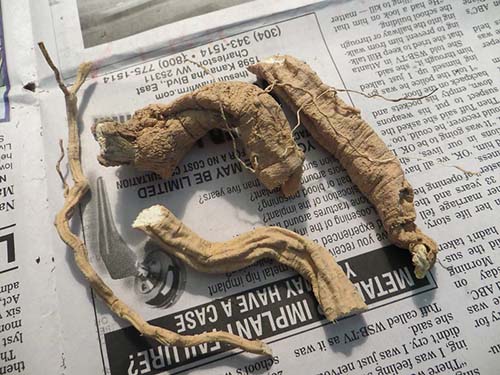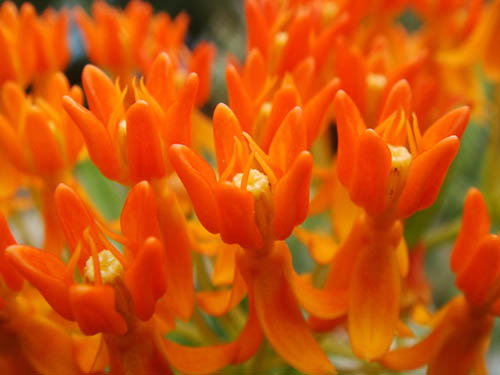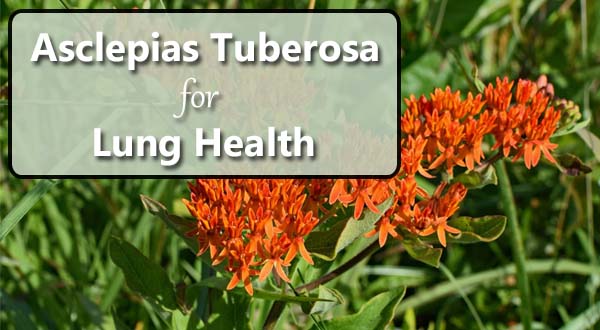Long before Asclepias tuberosa became a popular garden plant, it was used as a medicinal plant. It is especially known for treating lung issues like coughs, flu, pneumonia and asthma. Considering how important lung health is today, Asclepias tuberosa is a potent natural remedy you should consider adding to your first aid kit.
What Is Asclepias Tuberosa?

Asclepias tuberosa is a species of milkweed plant. It grows in dry, sandy soil in many parts of the United States and Lower Canada, so is easy to forage. Many people also grow the plant in their garden because it attracts butterflies. Unlike other milkweeds, Asclepias tuberosa has clear sap instead of white sap.
The Asclepias tuberosa species grows to be about 1.5 to 2.5 feet tall. It is a perennial and has small clusters of orange flowers and lots of thin leaves. Asclepias tuberosa roots are harvested in the fall and then dried.
Other Names for Asclepias Tuberosa
- Butterfly milkweed
- Orange butterfly weed
- Tuberosa milkweed
- Hello yellow
- Canada root
- Pleurisy root (when referring to just the root)
Asclepias Tuberosa Leaves vs. Root

When it comes to health benefits of Asclepias Tuberosa, it is almost always the roots which are mentioned. The roots have a long history of medicinal use, especially for coughs and lung ailments. There are some modern scientific studies which back up these benefits.
By contrast, not as much is known about the health benefits of Asclepias Tuberosa leaves. The leaves of other milkweed species do contain medicinal properties. Sometimes milkweed leaves are boiled and eaten or crushed and applied to wounds. The sap from milkweeds can be used as a natural wart remover.
Because milkweed species have a lot of similarities, it is possible that Asclepias Tuberosa leaves also have medicinal benefits. But, until there is more research, it’s better to stick to using the roots.
Is Asclepias Tuberosa Toxic?

Milkweeds leaves and stems contain sap which is mildly toxic to most animals (including humans). If consumed in large amounts, it can cause diarrhea and vomiting. You should also be careful not to touch your eyes after handling milkweeds: the sap can injure your eyes.
Because the root of Asclepias tuberosa is used medicinally (which does not contain any sap), you don’t have to worry about toxicity. The root is considered safe to use and has no serious side effects.
Benefits of Asclepias Tuberosa
Asclepias tuberosa has been used for centuries as a natural medicine. It was a big part of Native American medicine and was used by the Navajo, Iroquois, Cherokee, Blackfoot and Meskwaki. Once the pilgrims arrived in the Americas, they also started using it. You can find references to Asclepias tuberosa in old editions of pharmacology books.
Unfortunately, there hasn’t been too much research on the health benefits of Asclepias tuberosa. Below are the most promising benefits.
1. Lung Health
This is the main benefit of Asclepias tuberosa. It is known to help treat a variety of lung diseases and conditions, including:
- Bronchitis
- Pneumonia
- Asthma
It’s unclear how pleurisy root works exactly for help lungs. The benefits likely have to do with the plant’s ability to reduce lung inflammation and fight viruses and bacteria naturally. The plant also helps expel mucus built up in the lungs while relaxing lung tissue.
2. Bacterial and Viral Infections
Milkweeds are known to contain many natural antiviral and antimicrobial compounds. During the 1918 flu pandemic which killed an estimated 500 million people worldwide, Asclepias tuberosa was successfully used to treat patients.
3. Antispasmodic
Asclepias tuberosa is a well-known natural antispasmodic, which means it relaxes smooth muscle tissue. The antispasmodic activity of Asclepias tuberosa is one reason it helps sooth dry coughs. However, there are many other potential benefits of antispasmodics, such as for treating:
- Irritable bowel syndrome
- Cramps
- Anxiety
- Improving skin elasticity
4. Fights Inflammation
Another benefit of Asclepias tuberosa is that it naturally reduces inflammation in the body. We now know that inflammation is the root cause of numerous health conditions ranging from arthritis to psoriasis. Thus, Asclepias tuberosa could be used to treat many health problems. Though, if inflammation is your main concern, you might want to consider other remedies such as turmeric, Astractzlodes or fish mint plant.
5. Immune Health
Asclepias tuberosa promotes lymph production. The lymphatic system is our bodies’ frontline defense against infection and disease; it produces white blood cells which create antibodies. This is one more way that Asclepias tuberosa is good for treating infections.
6. Fertility and Female Health
Traditionally, Asclepias tuberosa has been used as a natural fertility treatment for women. There is an animal study which found that the plant increased fertility in rats but more research is needed. You’ll be better investing in a more well-researched natural fertility treatment, such as yams.
Note that Asclepias tuberosa should not be used by pregnant women. The plant can induce uterine contractions, which might cause premature labor.
How to Take Asclepias Tuberosa Root
Pleurisy root can be taken as a tincture, capsules, tea, or a powder. Note that pleurisy root has a very strong taste. It’s worth noting that the root has a very bitter taste. I personally find it disgusting, which is why I prefer to take pleurisy root as a tincture or capsule. Capsules usually also contain a blend of other natural supplements, especially when being used to treat coughs.
Dose:
- Tea: 1-4g of dried root, 3x per day
- Tinctures: 1-5ml, 3x per day (varies depending on concentration)
Warnings and Contraindications:
Don’t take Asclepias tuberosa if you are pregnant or breastfeeding. And, as with all natural medicines, always check with your healthcare provider first.
Best Brands of Asclepias Tuberosa
1. Herb Pharm Pleurisy Root Tincture
This pleurisy root tincture is organically grown on a farm in the USA. The brand is one of the more reputable companies and is very clear about how they grow and produce their products.
- 1 ounce bottle
- 1:4 menstruum ratio
- 250mg of herb per 1ml serving
- Certified organic
- 43-53% alcohol
- Buy here
2. Nature’s Answer Pleurisy Root Tincture
This pleurisy root tincture is incredibly concentrated. It also has a much lower alcohol content than other brands of tinctures. Despite this, it is still a very affordable product.
- 2 ounce bottle
- 2000mg of herb per 2ml serving
- 12-15% alcohol
- Buy here
3. Christopher’s Original Formulas Lung Plus Bronchial Supplement
Formulated specifically for lung support, this tincture contains a blend of Marshmallow root, mullein leaf, chickweed, lobelia, lungwort, and pleurisy root. Unfortunately, the brand doesn’t list the amount of alcohol in the tincture or amounts of each ingredient. However, it’s incredibly popular and said to be effective.
- 2 ounce bottle
- Blend of herbs
- Buy here
4. TerraVita Pleurisy Root Tea
If you don’t mind the taste of pleurisy root, this tea is one of the best ways to get the medicinal benefits of the plant (just make sure you don’t use boiling water to make the tea). I have yet to weigh the tea bags but they say that each bag contains 3-9 grams of the dried root. You can reuse the tea bags to get some more use out of them.
- 25 tea bags
- 3-9g of dried root per tea bag
- Buy here
Resources:
https://pfaf.org/user/plant.aspx?LatinName=Asclepias+tuberosa
https://www.sciencedirect.com/science/article/abs/pii/S0095955315318746
https://www.liebertpub.com/doi/full/10.1089/act.2017.29150.eyahttps://www.sciencedirect.com/science/article/pii/S2405661818300054
https://pfaf.org/user/plant.aspx?LatinName=Asclepias+tuberosa
https://webstu.onu.edu/garden/node/61
https://www.tandfonline.com/doi/full/10.3109/13880209.2015.1005752
https://www.jstage.jst.go.jp/article/cpb1958/48/7/48_7_1017/_article/-char/ja/
https://tpwd.texas.gov/huntwild/wild/species/butterflyweed/ http://tjhms.com/uploadfiles/5.%20Bronchial%20Asthma%20and%20its%20Lesser%20Known%20Homoeopathic%20Medicines.20201025112559.pdf
https://www.liebertpub.com/doi/abs/10.1089/act.2006.12.214,
https://books.google.rs/books?hl=en&lr=&id=UAitDwAAQBAJ&oi=fnd&pg=PA3&dq=asclepias+tuberosa+medicinal&ots=gpyeZZWdoq&sig=R1aSmKM7EHfH4–BPW-UsBxZhrU&redir_esc=y#v=snippet&q=tuberosa&f=false
Image credits:
“Asclepias tuberosa () 2019 photo” (CC BY-SA 2.0) by F. D. Richards,
“Dried Pleurisy Root. Photo by Katie Troz” (CC BY-ND 2.0) by Forest Farming,
“i love these flowers” (CC BY-NC-ND 2.0) by hit_the_snow





